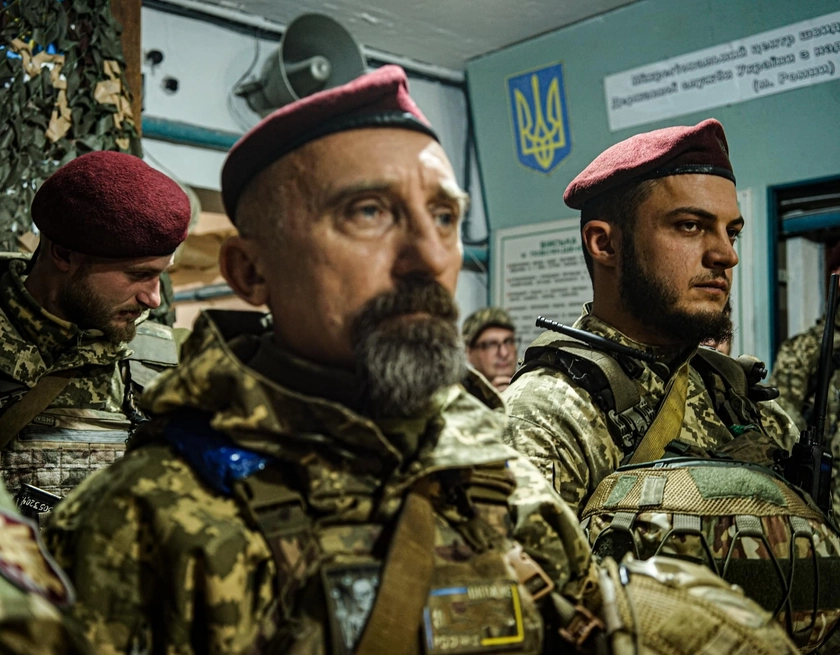Ukrainian drone operators recorded a Russian armored column driving toward Ukrainian Armed Forces positions under punishing artillery fire and getting destroyed.
Russian forces attacking in Ukraine’s eastern Avdiivka sector have shifted to massed infantry assaults following heavy, widely confirmed losses last week in tanks and armored personnel carriers, multiple sources reported on Monday.
JOIN US ON TELEGRAM
Follow our coverage of the war on the @Kyivpost_official.
Vitaly Barabash, head of the Avdiivka city administration, during a live feed on national television on Sunday evening, said that Kremlin troops had not stopped repeated attempts to gain ground on the battlefield on the outskirts of the Russia-occupied city of Donetsk, but they were running out of tanks and infantry fighting vehicles.
Defending Ukrainian infantry was under severe pressure but holding and hitting Russian attacks hard with drone-controlled artillery strikes and crew-served weapons, Barabash said.
A video recorded Friday showed the kind of damage Ukrainian forces have been inflicting on the Russians.
The video shows at least 14 Russian armored vehicles apparently forced to drive in single file to pass through minefields behind a mine-clearing tank attempting to make their way through high explosive and cluster munition strikes.
The majority of the force is BTRs (Soviet / post-Soviet military armored personnel carriers): half are shown to be knocked out or disabled and smoking at the end of the attack, and Ukrainian positions seem intact.

Fighting Across Ukraine War Front Fierce but Static
A close-up in the two-minute edited video shows at least five Russian infantrymen jumping off a BTR near Ukrainian positions. A Ukrainian anti-tank rocket fired at close range hits the BTR in seconds.
Just spectacular
— 🇺🇦Ukraine Resists Russian Genocide... Yeah Again (@ArmedMaidan) October 23, 2023
“One of the greatest destructions of Russian columns filmed from start to finish”
Avdiivka: “The assault begins. A Russian column of armored vehicles advances across a field covered with frost. Everything is according to science: there is a mine trawl ahead…… pic.twitter.com/1cpe4YrYOc
Ukrainian military journalist Yury Butusov on Monday reported that concerted Russian attacks over the past two weeks in the Avdiivka sector, in attempted pincer attacks to the west of the city, had gained about 1.5 km (nearly a mile) of ground in a salient about one kilometer wide (~0.6 miles), The Russian offensive had stalled at the foot of a mining slag heap some 50 meters (~164 feet) tall to Avdievka’s north, he reported.
Russian ground troops were attempting to dig in at the foot of the slag heap under extremely heavy Ukrainian artillery fire and trying to reinforce the toehold with more infantry riding trucks or advancing on foot, Ukrainian media reported.
Kremlin forces had by Sunday stopped trying to advance aboard armored vehicles, likely due to very heavy equipment losses suffered over the past week, Butusov said. Russian infantry losses were mounting under continuous Ukrainian artillery fire, he said.
Terrain around Adviivka is relatively open with little cover for large military units to hide, particularly from observation drones. Continuing, intense fighting in the sector has produced a recent flood of Ukrainian drone video of Russian armored vehicles out in the open, on the Avdiivka battlefield, and being destroyed in catastrophic explosions.
According to Ukrainian army statements generally confirmed by Russian military bloggers, the Kremlin on Oct. 10 launched a substantial ground offensive in the Avdiivka sector with the objective of capturing Ukrainian fortifications in the area by surrounding them with armored attacks from the north and the south.
The offensive has, according to reports, proved to be one of the most ambitious Russian ground operations of 2023. Ukrainian military intelligence has, reportedly, identified at least eight major, brigade-sized combined arms formations delegated to the offensive, including a “Spetsnaz” special operations brigade – all under the command of Russia’s 1st Combined Arms Corps.
Ukrainian military analysts generally estimate the Russian high command has committed between 300-600 armored vehicles and at least 10,000 men towards Avdiivka’s capture.
The last time Moscow attempted a major conventional arms assault in Ukraine, in February 2023, a tank and infantry formation about half that size was cut to pieces attacking Ukrainian infantry and artillery deeply dug in around the town of Vuhledar.
Ukrainian defenses around Avdiivka, the site of the latest Russian offensive push, were first constructed in 2014-15 and are counted to be the deepest and strongest fortifications on the entire front.
Ukrainian media has identified four formations as primarily responsible for defending Avdiivka: the 53rd and 110th Mechanized Brigades, and the 116th and 129th Territorial Defense Brigades. The 53rd is a veteran unit originally raised in Ukraine’s western Rivne region in 2014 to repel Russia’s first invasion of Ukraine.
The 110th is a new brigade formed in early 2023, in part with soldiers trained by NATO instructors. Manpower for the 116th and 129th is drawn respectively from Poltava and Kryvyi Rih residents volunteering for local defense forces. Most of Ukraine’s territorial defense brigades send contingents from home base territories to the eastern front, to back up regular troops.
Russian losses around Adviivka over the past three weeks have been heavy and by some accounts horrific. Most independent estimates place total Russian armored vehicle losses since Oct. 10 in the sector at around 200 tanks and infantry fighting vehicles. Ukrainian army kill claims are almost twice that.
Butusov reported Kyiv’s forces were holding under the Russian onslaught but tiring: “Our soldiers are tired from long battles. The Russians also hope that the Ukrainians will get tired of killing them. The defenders of Avdiivka need to be replenished and strengthened in order to be able to gradually give rest to the soldiers during 23 days of continuous combat.”
The Washington-based Institute for the Study of War (ISW) in a Monday morning situation estimate predicted Russian attacks at Avdiivka were likely to continue.
You can also highlight the text and press Ctrl + Enter






![[WATCH] Russian Dirt Bikes – No Match for Ukrainian Kamikaze Drones](https://static.kyivpost.com/storage/2025/01/27/9c6ad078d922242f67865201e2654ca3.png?w=840&f=webp)






